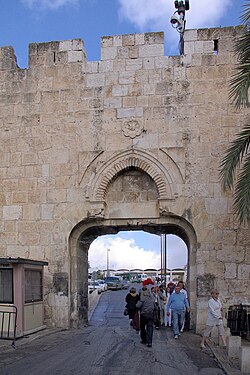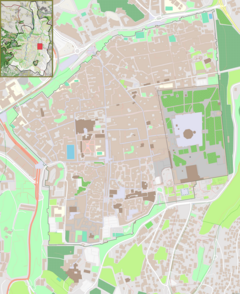| Revision as of 14:27, 20 April 2018 editXRaWCrazy (talk | contribs)120 editsNo edit summaryTags: Visual edit Mobile edit Mobile web edit← Previous edit | Revision as of 19:55, 1 May 2018 edit undoHavradim (talk | contribs)Extended confirmed users2,450 edits Corrected link to more accurate Western Wall PlazaNext edit → | ||
| Line 68: | Line 68: | ||
| The gate is situated near the southeast corner of the Old City, southwest of the ]. | The gate is situated near the southeast corner of the Old City, southwest of the ]. | ||
| Directly behind the gate lies the entrance to the ]. Dung Gate is a main passage for vehicles coming out of the Old City and for buses headed to the ]. | Directly behind the gate lies the entrance to the ]. Dung Gate is a main passage for vehicles coming out of the Old City and for buses headed to the ]. | ||
| The 16th-century gate was much smaller, but was enlarged in 1952, after the Old City came under ]ian control in 1948. After its capture by Israel in 1967, architect Shlomo Aronson was commissioned to renovate it.<ref>{{cite web |url= http://www.s-aronson.co.il/Selected-Projects-List.html |title= Landscape Selected Projects List by Shlomo Aronson |author=Shlomo Aronson |accessdate=2008-06-13 |archiveurl= https://web.archive.org/web/20080427225855/http://s-aronson.co.il/Selected-Projects-List.html |archivedate=2008-04-27 |deadurl=yes |df= }}</ref> | The 16th-century gate was much smaller, but was enlarged in 1952, after the Old City came under ]ian control in 1948. After its capture by Israel in 1967, architect Shlomo Aronson was commissioned to renovate it.<ref>{{cite web |url= http://www.s-aronson.co.il/Selected-Projects-List.html |title= Landscape Selected Projects List by Shlomo Aronson |author=Shlomo Aronson |accessdate=2008-06-13 |archiveurl= https://web.archive.org/web/20080427225855/http://s-aronson.co.il/Selected-Projects-List.html |archivedate=2008-04-27 |deadurl=yes |df= }}</ref> | ||
Revision as of 19:55, 1 May 2018
| Dung Gate | |
|---|---|
 Dung Gate Dung Gate | |
 | |
| General information | |
| Town or city | Jerusalem |
| Coordinates | 31°46′29″N 35°14′2″E / 31.77472°N 35.23389°E / 31.77472; 35.23389 |

The Dung Gate (Template:Lang-he Sha'ar Ha'ashpot), known in Arabic historically as the Moroccan or Mughrabi Gate (Template:Lang-ar) and since medieval times also known as Silwan Gate, is one of the gates in the walls of the Old City of Jerusalem. It was built in the 16th century.
The gate is situated near the southeast corner of the Old City, southwest of the Temple Mount.
Directly behind the gate lies the entrance to the Western Wall Plaza. Dung Gate is a main passage for vehicles coming out of the Old City and for buses headed to the Western Wall.
The 16th-century gate was much smaller, but was enlarged in 1952, after the Old City came under Jordanian control in 1948. After its capture by Israel in 1967, architect Shlomo Aronson was commissioned to renovate it.
Name
The name Sha'ar Ha'ashpot appears in the Book of Nehemiah 2:13-14. It is probably named after the residue that was taken from the Jewish Temple into the Valley of Hinnom, where it was burned. This ancient "Dung Gate" may not have been in the same location as the 16th-century gate, which only received this name in the 19th century.
The name Moroccan Gate (Bab al-Magharibeh) refers to the Moroccan Quarter, which was situated inside the gate until 1967.
The name Silwan Gate refers to the village of Silwan that lies outside and just south of the gate.
References
- ^ Jerusalem Municipality, Dung Gate
- Shlomo Aronson. "Landscape Selected Projects List by Shlomo Aronson". Archived from the original on 2008-04-27. Retrieved 2008-06-13.
{{cite web}}: Unknown parameter|deadurl=ignored (|url-status=suggested) (help)
External links
31°46′29″N 35°14′2″E / 31.77472°N 35.23389°E / 31.77472; 35.23389
| Temple Mount / Al-Aqsa | |||||||||||||
|---|---|---|---|---|---|---|---|---|---|---|---|---|---|
| Al-Aqsa |
| ||||||||||||
| Jewish elements |
| ||||||||||||
| Other components |
| ||||||||||||
| Excavations | |||||||||||||
| Conflicts | |||||||||||||
| See also | |||||||||||||
